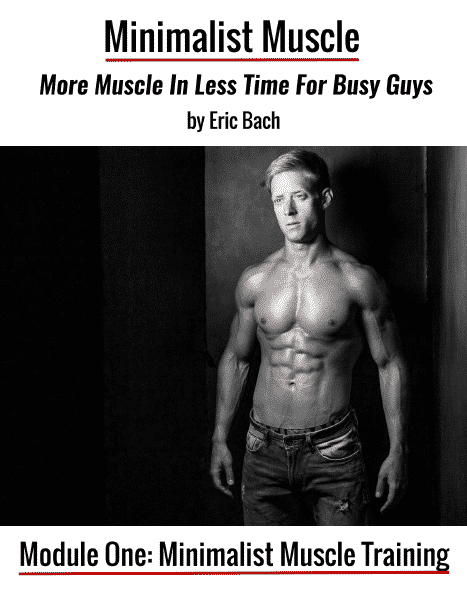Top 3 Muscle Building Training Splits For Dads
October 12, 2016
Have you ever wondered…
How can I exercise even when busy?
I know how frustrating it is to feel overwhelmed finding the right building muscle training splits for you.
You’re all ready to go and then, WHAM.
Like a blindside hit from a linebacker, life gets insane.
Your 45-hour weeks turn into 70 hour weeks.
Then your kids get sick.
Next thing you know, you’re coughing up a storm and pounding DayQuil to make it through the day.
Then you hit the NyQuil for a few hours of warped dreams and sleep.
Melodramatic? Maybe. But the point is:
It’s damn near impossible to find the “perfect” training split to achieve your goals with your busy schedule.
Welcome to the club. Many others share your challenges:
– limited time
– limited capacity for real change
– information overload
In this article, we’ll cover…
The Three Best Muscle Building Training Splits for Busy Dads
The two most important factors for transforming your body are consistency and progressive overload. The correct training split will fit your schedule to help you stay consistent even when life gets crazy while structuring your workout in a way to help you get stronger and build muscle via progressive overload.
Below I’ll cover the pros and cons of each split. With the benefits and drawbacks in mind, you’ll know enough to pick the right training split for you, your schedule, and your goals.
Related: The 8 Most Effective Training Splits
We’ll focus on your workout/ life balance: Your training needs to fit your busy lifestyle, not consume it. Without the right training split, you’ll find yourself skipping workouts and falling back into old habits.
P.S. After the post, be sure to check out the Minimalist Muscle Course. This is the definitive guide to maximizing strength and making lean gains without living in the gym. Join today.
How Should You Care About Muscle Building Training Splits?
If you’re curious about how to get better results in less time. This is perfect for you. Dig in, look at the workouts and see which looks best for you. Then, grab the Muscle Building guide featured at the bottom of the page. It will really help.
If you have plenty of time to train yet still want to spend less time in the gym. Pay attention to what every program features, and make sure you’re covering your bases.
If you’re a coach: Think about your clients and ask yourself if the situation described below sounds familiar? Consider tweaking your clients’ programs to improve consistency.
Overall: Remember context is key. If you’re a bodybuilder, this isn’t ideal for you.
You must grind. Conversely, there are also no absolutes in training. If training less often lets you train consistently and with progressive overload rather than missed workouts, then this is perfect for you.
The Big Picture on Muscle Building Training Splits
As long as you have progressive overload, sound nutrition, and an emphasis on recovery…
…a new split will bring fresh motivation, more muscle, and improved strength in the gym.
Despite what some might have you believe, there’s no “one size fits all” when it comes to training. Your training should depend on your goals, schedule, experience, and injury history.
New programs should fit into your lifestyle, rather than consuming it. but renewed motivation will have you attacking each workout with focus and intensity. You’ll build your strongest body yet.

Muscle Building Training Split: Total Body Training Split
Total body training splits are maximally efficient. They train the body as a unit, rather than as component parts.
Pros: Total body splits are maximally efficient for those short on time and looking for full body stimulation. High-frequency stimulation for muscles and moderate training volume suits many goals. Total body training minimizes fluff. It is for suitable beginners, fat loss, athletes, and general health.
Read More on High-Frequency Training here.
Cons: Low intra-workout volume may hinder metabolic stress-related hypertrophy. In non-science speak, that means you won’t be chasing the pump as often. Stronger lifters may struggle with recovering from heavy lifts or hitting the legs three times in one week.
It’s difficult to split to train more than three or four times per week, which drives many dedicated lifters crazy, leading to program hopping. Smaller “show” muscles like your biceps 🙁 may be neglected. That;s tough to swallow for dudes used to bodybuilding -style training.
Total Body Training Examples
Monday:
1.Squat 5×3
2.Bench Press 3×6
3.Lunge 3×8
4a.Farmer Walks 3×30 steps
4b. Dips 3×20
5. Isolation Work on medial delts, biceps, calves for 10-15 minutes
Tuesday: OFF
Wednesday:
1.Deadlift 5×3
2.Dumbbell Overhead Press 4×6
3.Chin Up 3×8-12
4a.Plank 3×30 seconds
4b. Biceps Curl 3x 12
5. Isolation Work on medial delts, biceps, calves for 10-15 minutes
Thursday: OFF
Friday:
1.Back Squat 5×3
2.Bent Over Row 4×6
3.Dumbbell Bench Press 3×8
4a. Dumbbell Curl 3×12
4b. Hip Thrust 3×12
5. Isolation Work on medial delts, biceps, calves for 10-15 minutes
Saturday/Sunday: Off/Conditioning
Muscle Building Training Split 2: Upper/Lower Training Split
Upper-lower training splits allow for more recovery and training volume than total body splits. Upper body and lower body days alternate for four workouts in a seven-day training split.
Pros: Upper-Lower training splits are a great progression from total body training and work well with most people. Upper-Lower splits allow greater training frequency for quicker learning and mastery.
But they still use heavy weights to drive strength gains. Upper-lower splits offer a moderate training frequency and moderate-high volume. This is a recipe for solid, but not spectacular, gains in muscle size.
Cons: Training days can be unbalanced. Upper body workouts tend to take much longer than lower body sessions, making scheduling hit or miss. Upper-lower training splits offer shorter recovery time between training sessions compared to body-part splits.
This may hinder recovery. And there’s this: Lower body training is brutal. Doing it two times per week might be too much for beginners.
Upper/Lower Split Examples
Monday: Upper Body
Tuesday: Lower Body
Wednesday: Off/active recovery
Thursday: Upper Body
Friday: Lower
Saturday/Sunday: Off
P.S. Struggling to put together your perfect routine? Enroll in Minimalist Muscle Course today. This is the definitive guide to maximizing strength and making lean gains without living in the gym. Join today.
Muscle Building Training Split Three: Push-Pull-Lower Body Training Split
Push-Pull- Lower Body training splits break training up by upper body push (bench press or overhead press), upper body pull (rows and chins), and lower body training (squats or deadlifts). This allows for more volume to be given muscle groups on their select day.
Pros: Push-Pull-Lower body routines are suitable for intermediate to advanced trainees. They’re very economical, allowing you to hit a variety of movements for a muscle group on each day. This increases your ability to create muscular damage and metabolic stress, two drivers of muscle growth. Best of all, they are fun! They allow for more isolation work than other workout routines.
Cons: Push-pull splits are limited for those training for athletic performance because they segregate the body by muscles that work together. For beginners, they only hit big movement patterns like a squat or hinge once per week– which may lead to slower gains in strength and technique. Overall, these are great for intermediates and advanced lifters, but not beginners.
Push/Pull/Lower Body Training Example
Monday: Pull
1a. Medicine ball Slam 2×5
1b. Box Jump 2×5
2. Chin Up 4×6
3. Bent Over Barbell Row 4×8
4a. Wide Grip Cable Row 3×12-15
4b. 1/2 Kneeling Pallof Press 3×12-15
5. Barbell Curl 3×8
6. Hammer Curl 3×12/each
Tuesday: OFF
Wednesday Push:
1. Med ball Chest Pass 2×8
2. Close Grip Bench Press 4×5
3. Dumbbell Seated Military Press 3×8
4a. Incline Dumbbell Bench Press 3×10
4b. Chest supported Row 3×12
5a. Feet elevated push up 3×10
5b. Triceps rope pushdown 3×10
5c. Dumbbell lateral raise 3×10
Thursday: Off
Friday: Lower
1a. Box Jump 3×5
1b. Plank 3×45-60 seconds
2. Front Squat 4×5
3. Barbell RDL 4×8
4a. Dumbbell Walking Lunge 3×10 each
4b. Ab Wheel Rollout 3×10
5a. Calf Raise 3×15
5b. Stability Ball crunch 3×15
Saturday/Sunday: OFF
Muscle Building Training Split Considerations
What’s your goal? To maximize your training split, your goals must be clear. Since your time is limited, you can’t isolate every muscle group and pound it into oblivion. You can do anything, but not everything. Pick one or two muscles you’d like to focus on, and do all your isolation work on that muscle for 4-6 weeks. Then move onto the next muscle group.
What’s your schedule? Regardless of how “busy” you are you still have 24 hours every day…just like the rest of us. So prioritize. If training two hours a day, five days a week isn’t ideal, simply pick a more efficient split. A workout is only as good as it’s execution. Determine what you can realistically do. And then do it.
P.S. To eliminate the guesswork, I’ve produced a course to help busy people like you make incredible gains without living in the gym. The Minimalist Muscle course is the definitive guide to maximizing strength and making lean gains without living in the gym. Join today.
Training Age. Beginners jump into body part splits and isolation workouts before they’re strong enough to reap the rewards of focused isolation. Older lifters find they can’t train as hard as often due to greater neural requirements, joint stress, and recovery. Pick a training split that challenges you, but doesn’t provide more than you’re able to recover from.
Recoverability. The body is an integrated system. Rather than looking at recovery based on how your muscles feel, you must take into account everyday stress, the nervous system, sleep quality, and nutrition.
Effort: Because you’re training less often you need to be 100% focused. No skipped workouts. No Snapchat (or whatever else you do when you’re supposed to be lifting), and no excuses. Get in, get focused, and maximize your minimal time.
Here’s a personal story to illustrate the recoverability point. A few years ago I worked in a typical big box gym. I didn’t have to stress my body much during sessions. Then I moved on to work with a predominantly athletic population. I do tons of hands-on demonstrations with sprints, jumps, throws, and other techniques. The volume and intensity added up. I couldn’t train as hard and heavy as I could previously.
The takeaway? Take into account all the stressors in your training. Adapt based on how your body feels.
Muscle Building Training Splits: Wrap Up
There’s more than one way to do things. The body-part split you’re doing today might not be the best for you. There is great individual variation.
And some people, especially the time-pressed, might respond best to total body training splits to lock inconsistency and progressive overload.
The ideas outlined above should inspire some fresh thinking about what’s best for you.
Bottom line: Don’t overcomplicate things. Find a program that fits your schedule and goals. Stick with it for a few months, and progressively add weight and volume. Reassess as required, and keep your pedal to the metal. Your program is only as effective as the effort behind it. Will you step up to the plate?
Join the Minimalist Muscle Movement today.
It’s a state-of-the-art weight-lifting and nutritional blueprint for “skinny” guys who want to pack on muscle without living in the gym. Join today.
References
Kelleher, A., Hackney, K., Fairchild, T., Keslacy, S., & Ploutz-Snyder, L. (2010, April 1). The Metabolic Costs of Reciprocal Supersets vs. Traditional Resistance Exercise in Young Recreationally Active Adults. Retrieved October 20, 2014.
Schoenfeld, B. (2010). The Mechanisms of Muscle Hypertrophy and Their Application to Resistance Training. Journal of Strength and Conditioning Research, 24(10), 2857-2872. Retrieved October 20, 2014.










Your post is helpful that so amazing!
Awesome post! You mentioned all the important aspects – rest, nutrition, overload, time. Your program really shouldn’t consume your life because if you don’t like your workout you won’t stay consistent and see the results you desire. Thank you for sharing!
Thank you, Michael!